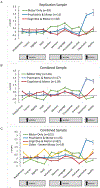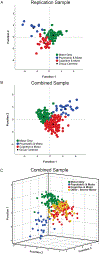Replication and reliability of Parkinson's disease clinical subtypes
- PMID: 38838453
- PMCID: PMC11590651
- DOI: 10.1016/j.parkreldis.2024.107016
Replication and reliability of Parkinson's disease clinical subtypes
Abstract
Background: We recently identified three distinct Parkinson's disease subtypes: "motor only" (predominant motor deficits with intact cognition and psychiatric function); "psychiatric & motor" (prominent psychiatric symptoms and moderate motor deficits); "cognitive & motor" (cognitive and motor deficits).
Objective: We used an independent cohort to replicate and assess reliability of these Parkinson's disease subtypes.
Methods: We tested our original subtype classification with an independent cohort (N = 100) of Parkinson's disease participants without dementia and the same comprehensive evaluations assessing motor, cognitive, and psychiatric function. Next, we combined the original (N = 162) and replication (N = 100) datasets to test the classification model with the full combined dataset (N = 262). We also generated 10 random split-half samples of the combined dataset to establish the reliability of the subtype classifications. Latent class analyses were applied to the replication, combined, and split-half samples to determine subtype classification.
Results: First, LCA supported the three-class solution - Motor Only, Psychiatric & Motor, and Cognitive & Motor- in the replication sample. Next, using the larger, combined sample, LCA again supported the three subtype groups, with the emergence of a potential fourth group defined by more severe motor deficits. Finally, split-half analyses showed that the three-class model also had the best fit in 13/20 (65%) split-half samples; two-class and four-class solutions provided the best model fit in five (25%) and two (10%) split-half replications, respectively.
Conclusions: These results support the reproducibility and reliability of the Parkinson's disease behavioral subtypes of motor only, psychiatric & motor, and cognitive & motor groups.
Keywords: Classification; Latent class analysis; Parkinson disease; Psychometrics.
Copyright © 2024 The Authors. Published by Elsevier Ltd.. All rights reserved.
Conflict of interest statement
Declaration of competing interest The authors declare the following financial interests/personal relationships which may be considered as potential competing interests. Therese Cash received support from NIH (NS097437, NS075321, NS097799, NS124738, NS118146, AT011015). Christina N. Lessov-Schlaggar received support from NINDS NS097437. Erin R. Foster is funded by the National Institutes of Health (NIA R21AG063974, NIA R01AG065214, NIDDK R01DK126826, R01DK064832), the American Parkinson Disease Association (APDA) (ID# 971,949), and the APDA Advanced Parkinson Disease Research Center at Washington University in St Louis, and the Missouri Chapter of the APDA. Peter S. Myers received support from NINDS NS097437. Joshua J. Jackson received support from NINDS NS097437, NIMH AG061162-01, NIDCD DC017522-02S1. Baijayanta Maiti received funding from NINDS K23 NS125107, National Center for Advancing Translational Sciences of the National Institute of Health KL2 TR002346, American Academy of Neurology and American Brain Foundation Clinical Research Training Fellowship in Parkinson's disease, Parkinson Study Group/Parkinson's Disease Foundation Mentored Clinical Research Award, Missouri Chapter of American Parkinson Disease Association, and the Jo Oertli fund and has received honoraria for reviewing grants as a member of the Parkinson Study Group mentoring committee and from the American Academy of Neurology for authorship. Paul T. Kotzbauer received funding from National Institutes of Health NS110436, NS097799, NS075321, NS110456, AG071754, NS123860, NS097437, and from Biogen and has received previous funding and honoraria from AbbVie. Joel S. Perlmutter has received research funding from National Institutes of Health NS075321, NS103957, NS107281, NS092865, U10NS077384, NS097437, U54NS116025, U19 NS110456, AG050263, AG-64937, NS097799, NS075527, ES029524, NS109487, R61 AT010753, (NCATS, NINDS, NIA), R01NS118146, R01AG065214, Department of Defense (DOD W81XWH-217-1-0393), Michael J FoxFoundation, Barnes-Jewish Hospital Foundation (Elliot Stein Family Fund and Parkinson disease research fund), American Parkinson Disease Association (APDA) Advanced Research Center at Washington University, Missouri Chapter of the APDA, Paula and Rodger Riney Fund, Jo Oertli Fund, Huntington Disease Society of America, Murphy Fund, N. Grant Williams Fund and CHDI. He co-directs the Dystonia Coalition, which received the majority of its support through the NIH (grants NS116025, NS065701 from the National Institutes of Neurological Disorders and Stroke, TR 001456 from the Office of Rare Diseases Research at the National Center for Advancing Translational Sciences). Dr. Perlmutter has provided medical legal consultation to Wood, Cooper and Peterson, LLC and to Simmons and Simmons LLP. He serves as Director of Medical and Scientific Advisory Committee of the Dystonia Medical Research Foundation, Chair of the Scientific Advisory Committee of the Parkinson Study Group, Chair of the Standards Committee of the Huntington Study Group (honoraria for this one), member of the Scientific Advisory Board of the APDA, Chair of the Scientific and Publication Committee for ENROLL-HD (honoraria from this one), and member of the Education Committee of the Huntington Study Group (honoraria from this one). Dr. Perlmutter has received honoraria from CHDI, Huntington Disease Study Group, Parkinson Study Group, Beth Israel Hospital (Harvard group), U Pennsylvania, Stanford U. Boston University. Meghan C. Campbell receives research support from NIH (NS097437, NS075321, NS097799, NS124378, AG063974, AT010753, AT010753-S1), the McDonnell Center for Systems Neuroscience, the Mallinckrodt Institute of Radiology at WUSTL, the Neurimaging Labs Innovation Award and has received honoraria from the Parkinson Foundation.
Figures


References
-
- Thenganatt MA, Jankovic J, Parkinson disease subtypes, JAMA Neurol. 71 (2014) 499–504. - PubMed
-
- Jankovic J, McDermott M, Carter J, Gauthier S, Goetz C, Golbe L, Huber S, Koller W, Olanow C, Shoulson I, . Variable expression of parkinson's disease: A baseline analysis of the datatop cohort. The parkinson study group, Neurology. 40 (1990) 1529–1534. - PubMed
-
- Nutt JG, Motor subtype in parkinson's disease: Different disorders or different stages of disease?, Mov Disord. (2016) - PubMed
-
- Erro R, Vitale C, Amboni M, Picillo M, Moccia M, Longo K, Santangelo G, De Rosa A, Allocca R, Giordano F, Orefice G, De Michele G, Santoro L, Pellecchia MT, Barone P, The heterogeneity of early parkinson's disease: A cluster analysis on newly diagnosed untreated patients, PLoS One. 8 (2013) e70244. - PMC - PubMed
MeSH terms
Grants and funding
- U19 NS110456/NS/NINDS NIH HHS/United States
- R01 AG061162/AG/NIA NIH HHS/United States
- U54 NS116025/NS/NINDS NIH HHS/United States
- RF1 AG064937/AG/NIA NIH HHS/United States
- R01 NS075321/NS/NINDS NIH HHS/United States
- R01 DK126826/DK/NIDDK NIH HHS/United States
- R01 NS124738/NS/NINDS NIH HHS/United States
- R01 NS097437/NS/NINDS NIH HHS/United States
- R01 NS097799/NS/NINDS NIH HHS/United States
- RF1 NS075321/NS/NINDS NIH HHS/United States
- R01 NS092865/NS/NINDS NIH HHS/United States
- K01 DC017522/DC/NIDCD NIH HHS/United States
- K23 NS125107/NS/NINDS NIH HHS/United States
- R01 DK064832/DK/NIDDK NIH HHS/United States
- R01 NS109487/NS/NINDS NIH HHS/United States
- R01 NS107281/NS/NINDS NIH HHS/United States
- R33 AT010753/AT/NCCIH NIH HHS/United States
- R34 AT011015/AT/NCCIH NIH HHS/United States
- R01 AG050263/AG/NIA NIH HHS/United States
- RF1 NS110436/NS/NINDS NIH HHS/United States
- R01 NS103957/NS/NINDS NIH HHS/United States
- R01 AG065214/AG/NIA NIH HHS/United States
- U54 TR001456/TR/NCATS NIH HHS/United States
- R21 NS123860/NS/NINDS NIH HHS/United States
- R01 NS075527/NS/NINDS NIH HHS/United States
- U01 NS110436/NS/NINDS NIH HHS/United States
- KL2 TR002346/TR/NCATS NIH HHS/United States
- R01 ES029524/ES/NIEHS NIH HHS/United States
- U54 NS065701/NS/NINDS NIH HHS/United States
- U19 AG071754/AG/NIA NIH HHS/United States
- R21 AG063974/AG/NIA NIH HHS/United States
- R01 NS118146/NS/NINDS NIH HHS/United States
- R61 AT010753/AT/NCCIH NIH HHS/United States
- U10 NS077384/NS/NINDS NIH HHS/United States
LinkOut - more resources
Full Text Sources
Medical
Research Materials

